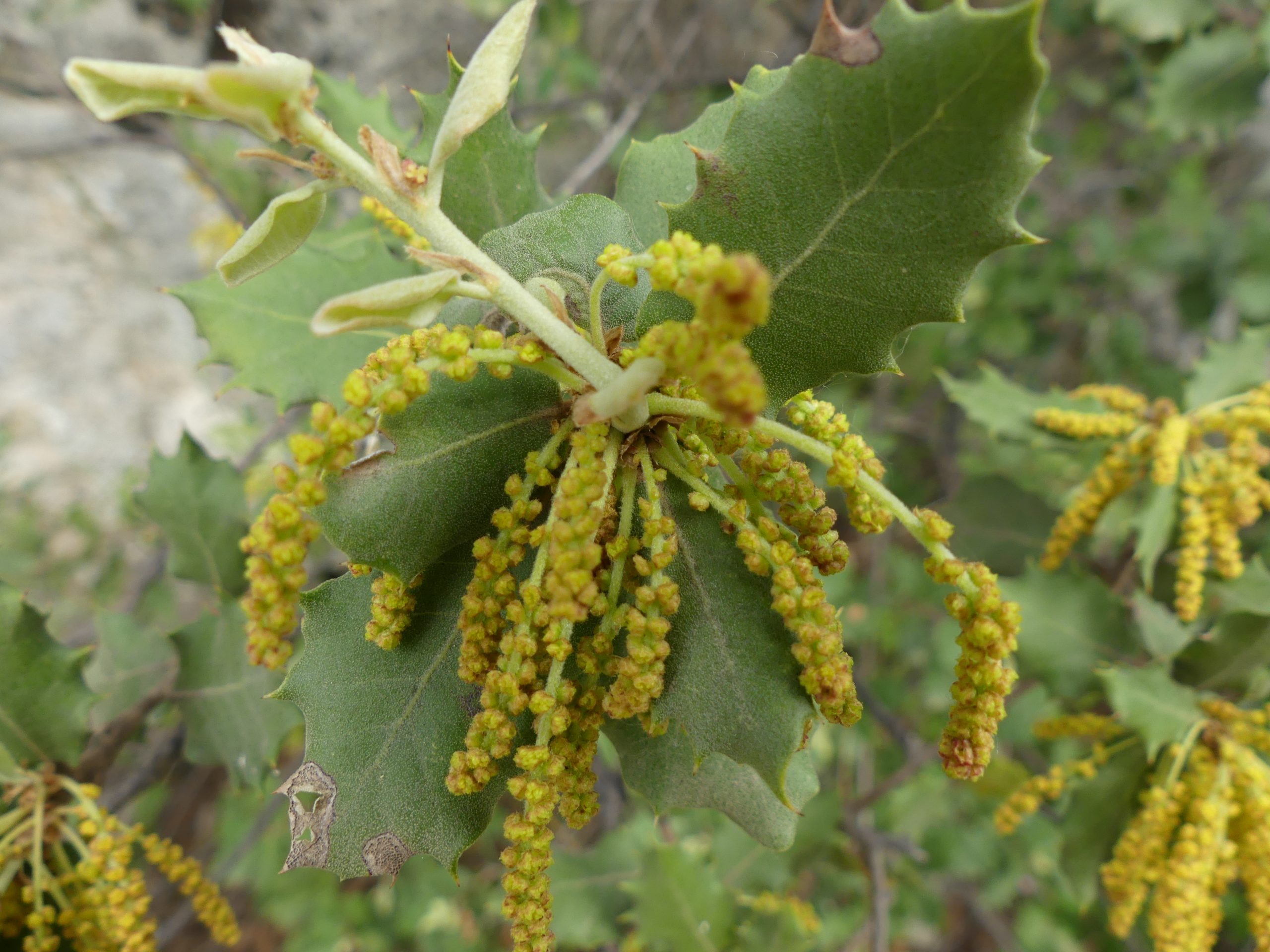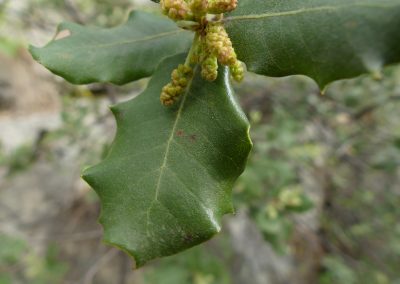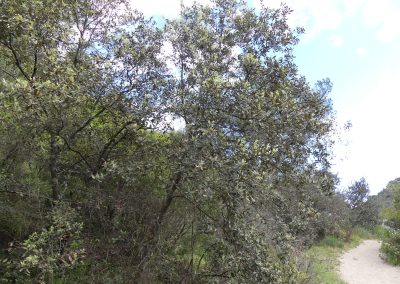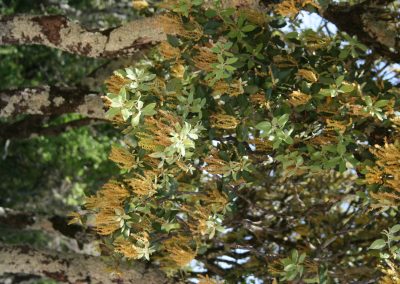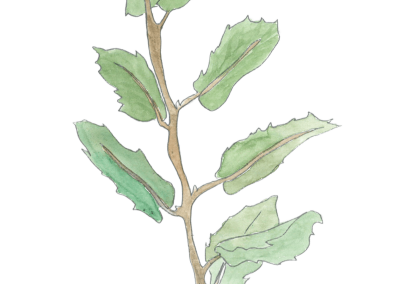Quercus ilex
Scientific description
Taxon: Quercus ilex
Class: Eudicotyledons
Subclass: Rosids
Order: Fagales
Family: Fagaceae
Common name: Holm oak, Evergreen oak
Origin:
Mediterranean region.
Description:
Evergreen tree or shrub, 2–15 m (sometimes up to 25 m). Bark grey, slightly fissured. Leaves oval to lanceolate, entire or spiny-edged, dark green above, whitish and downy beneath. Flowers bloom April–May.
Propagation:
By acorns, mostly dispersed by birds. Germinates naturally in autumn or spring.
Ecology:
Typical of Mediterranean dry forests and scrub, on calcareous or rocky slopes, hillsides, and garrigue.
Use:
Hard wood for firewood and carpentry. Foliage consumed by livestock. Key species in drought-prone Mediterranean habitats.
Threat:
Least Concern. Resilient but locally vulnerable to wildfires and habitat fragmentation.
Taxon: Quercus ilex
Classe: Eudicotylédones
Sous-classe: Rosidées
Ordre: Fagales
Famille: Fagacées
Nom commun: Chêne vert, Yeuse
Origine:
Région méditerranéenne.
Description:
Arbre ou arbrisseau persistant, 2–15 m (parfois jusqu’à 25 m). Écorce grise et peu fissurée. Feuilles ovales à lancéolées, entières ou dentées, vert foncé dessus, blanchâtres et duveteuses dessous. Floraison avril–mai.
Multiplication:
Par glands dispersés par les animaux, germination à l’automne ou au printemps.
Écologie:
Essence typique des forêts et maquis méditerranéens secs, sur sols calcaire ou pierreux.
Utilisation:
Bois dur pour chauffage et menuiserie. Feuillage consommé par le bétail. Essentiel pour les écosystèmes méditerranéens secs.
Menaces:
Préoccupation mineure. Résilient mais localement sensible aux incendies et à la fragmentation de l’habitat.
Taxon: Quercus ilex
Clasă: Eudicotiledonate
Subclasă: Rosidae
Ordin: Fagales
Familie: Fagaceae
Nume comun: Stejar veșnic verde
Origine:
Regiunea mediteraneană.
Descriere:
Arbore sau arbust persistent, 2–15 m (uneori până la 25 m). Scoarța gri, slab crăpată. Frunze ovale până la lanceolate, întregi sau spinoase, verde-închis pe față, albicioase și pufoase pe dos. Înflorire aprilie–mai.
Propagare:
Prin ghinde, răspândite de păsări. Germinare toamna sau primăvara.
Ecologie:
Tipică pădurilor uscate și maquis mediteranean, pe pante calcaroase sau stâncoase.
Utilizare:
Lemn dur pentru foc și tâmplărie. Frunziș consumat de animale. Specie cheie în habitatele mediteraneene afectate de secetă.
Amenințări:
Risc scăzut, rezistent, dar vulnerabil local la incendii și fragmentarea habitatului.
Ταξινόμηση: Quercus ilex
Κλάση: Eudicotyledonae
Υποκλάση: Rosidae
Τάξη: Fagales
Οικογένεια: Fagaceae
Κοινή ονομασία: Αριά, Χνοώδης δρυς
Προέλευση:
Μεσογειακή περιοχή.
Περιγραφή:
Αειθαλές δέντρο ή θάμνος, 2–15 μ. (έως 25 μ.). Φλοιός γκρι και σχεδόν λείος. Φύλλα ποικίλου σχήματος: ωοειδή έως λογχοειδή, ακέραια ή με αγκάθια, σκουροπράσινα πάνω, λευκά και τριχωτά κάτω. Ανθοφορία Απρίλιο–Μάιο.
Πολλαπλασιασμός:
Με βελανίδια, κυρίως διασκορπισμένα από πουλιά. Φύτρωση φθινόπωρο ή άνοιξη.
Οικολογία:
Χαρακτηριστικό των ξηρών μεσογειακών δασών και θάμνων, σε ασβεστολιθικά ή πετρώδη εδάφη.
Χρήση:
Σκληρό ξύλο για καύση και ξυλουργική. Φύλλα για βόσκηση. Σημαντικό είδος για ξηρές μεσογειακές περιοχές.
Απειλή:
Είδος ελάχιστης ανησυχίας. Ανθεκτικό, αλλά τοπικά ευαίσθητο σε πυρκαγιές και κατακερματισμό οικοτόπων.
Creative writing inspired by Quercus ilex
The holm oak
A long time ago, a horrible monster with the ability to fly was looking for a strange creature called “La Chenopode”, a cross between an animal and a plant. He wanted to eat it, because apparently it tasted like hazelnuts and had the power to make you stronger. This Chénopode herself had a mission: not to be eaten by this monster. In other words, her objective was to flee. Strange, isn't it? But the Chenopode also had the ability to fly, so she was confident she wouldn't be eaten.
Miraculously, she found a flying castle, went there and intended to stay. She stayed in the castle for about two hours, but had the constant feeling that she was being watched. She took fright and hid in a cupboard; indeed, there was someone else in the castle. When she heard footsteps approaching the cupboard, she shivered with fear: it was the monster, and unluckily, he lived in the castle.
Chénopode quickly got out of the wardrobe and tried to run away. The monster didn't hesitate to follow! The monster was strong and surprisingly fast, so he got within striking distance and ate her. But as he digested her, he transformed into the holm oak we know today. This plant is considered a symbol of strength, longevity and resistance.


